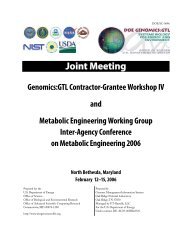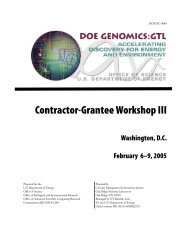Joint Meeting - Genomics - U.S. Department of Energy
Joint Meeting - Genomics - U.S. Department of Energy
Joint Meeting - Genomics - U.S. Department of Energy
You also want an ePaper? Increase the reach of your titles
YUMPU automatically turns print PDFs into web optimized ePapers that Google loves.
4<br />
Systems Biology for DOE <strong>Energy</strong> and Environmental Missions<br />
bi<strong>of</strong>uel production; integrate information from multiple<br />
research approaches; and develop predictive models for<br />
relevant enzymes, pathways, or networks that can guide<br />
the development <strong>of</strong> new plants, enzymes, or microbes<br />
that would enhance a bi<strong>of</strong>uel-production pipeline.<br />
Education and Outreach: With a history <strong>of</strong> excellence<br />
in the land-grant missions <strong>of</strong> education, training, and<br />
outreach, the GLBRC is committed to training the<br />
bioenergy leaders <strong>of</strong> tomorrow while removing today’s<br />
bottlenecks in the bi<strong>of</strong>uels pipeline. The GLBRC academic<br />
partners will <strong>of</strong>fer new bioenergy-focused summer<br />
research programs, seminars, special courses and labs. By<br />
working with existing university programs, GLBRC scientists<br />
will develop workshops and educational modules<br />
for K–12 teachers on carbon chemistry, sustainability, and<br />
biodiversity issues related to bi<strong>of</strong>uel production. GLBRC<br />
researchers will also develop general education materials<br />
and host public forums to raise awareness <strong>of</strong> and generate<br />
support for bi<strong>of</strong>uels among farmers and communities.<br />
GTL<br />
2<br />
The <strong>Joint</strong> Bio<strong>Energy</strong> Institute (JBEI):<br />
Biomass Conversion to Alternative<br />
Transportation Fuels<br />
Jay Keasling 1,2 * (jdkeasling@lbl.gov), Harvey<br />
Blanch, 1,2 Wolf Frommer, 3 Blake Simmons, 4 Paul<br />
Adams, 1 and Kathe Andrews-Cramer 5<br />
1 Lawrence Berkeley National Laboratory, Berkeley,<br />
California; 2 University <strong>of</strong> California, Berkeley,<br />
California; 3 Carnegie Institution for Science, Stanford,<br />
California; 4 Sandia National Laboratory, Livermore,<br />
California; and 5 Sandia National Laboratory,<br />
Albuquerque, New Mexico<br />
Project Goals: This Bio<strong>Energy</strong> Research Center’s<br />
program is directed at conversion <strong>of</strong> lignocellulosic<br />
biomass to transportation fuels.<br />
Today, carbon-rich fossil fuels, primarily oil, coal and<br />
natural gas, provide 85% <strong>of</strong> the energy consumed in the<br />
United States. The release <strong>of</strong> greenhouse gases from<br />
these fuels has spurred research into alternative, non-fossil<br />
energy sources. Lignocellulosic biomass is renewable<br />
resource that is carbon-neutral, and can provide a raw<br />
material for alternative transportation fuels. Plant-derived<br />
biomass contains cellulose, which is difficult to convert to<br />
monomeric sugars for production <strong>of</strong> fuels. The development<br />
<strong>of</strong> cost-effective and energy-efficient processes to<br />
transform the cellulosic content <strong>of</strong> biomass into fuels is<br />
* Presenting author<br />
hampered by significant roadblocks, including the lack <strong>of</strong><br />
specifically developed energy crops, the difficulty in separating<br />
biomass components, the high costs <strong>of</strong> enzymatic<br />
deconstruction <strong>of</strong> biomass, and the inhibitory effect <strong>of</strong><br />
fuels and processing byproducts on organisms responsible<br />
for producing fuels from biomass monomers.<br />
The <strong>Joint</strong> Bio<strong>Energy</strong> Institute ( JBEI) is addressing these<br />
roadblocks in bi<strong>of</strong>uels production. JBEI draws on the<br />
expertise and capabilities <strong>of</strong> three national laboratories<br />
(Lawrence Berkeley National Laboratory (LBNL),<br />
Sandia National Laboratories (SNL), and Lawrence<br />
Livermore National Laboratory (LLNL)) two leading<br />
U.S. universities (University <strong>of</strong> California campuses at<br />
Berkeley (UCB) and Davis (UCD), and the Carnegie<br />
Institution for Science at Stanford University to provide<br />
the scientific and technology underpinnings needed to<br />
convert the energy stored in cellulose into transportation<br />
fuels and other chemicals. Based in Emeryville,<br />
California, JBEI co-locates scientists and engineers from<br />
all the member organizations. JBEI’s approach is based<br />
in three interrelated scientific divisions and a technologies<br />
division. The Feedstocks Division will create the<br />
knowledge required to develop improved plant energy<br />
crops to serve as the raw materials for bi<strong>of</strong>uels. The<br />
Deconstruction Division will investigate the conversion<br />
<strong>of</strong> this lignocellulosic plant material to usable forms <strong>of</strong><br />
sugars and aromatics. The Fuels Synthesis Division will<br />
create microbes that can efficiently convert sugar and<br />
aromatics into ethanol, butanol and advanced bi<strong>of</strong>uels.<br />
JBEI’s cross-cutting Technologies Division will develop<br />
and optimize a set <strong>of</strong> enabling technologies—including<br />
high-throughput, chip-based and ‘omics platforms, tools<br />
for synthetic biology, multi-scale imaging facilities, and<br />
integrated data analysis. This division thus supports and<br />
integrates the scientific programs.<br />
The objectives and approaches <strong>of</strong> JBEI’s divisions will be<br />
described, together with the initial research accomplishments<br />
<strong>of</strong> each <strong>of</strong> JBEI’s divisions.<br />
JBEI web site: www.jbei.org<br />
3<br />
The Bio<strong>Energy</strong> Science Center: An<br />
Overview<br />
Martin Keller* (kellerm@ornl.gov)<br />
GTL<br />
Oak Ridge National Laboratory, Oak Ridge, Tennessee<br />
Project Goals: By combining engineered plant cell<br />
walls to reduce recalcitrance with new biocatalysts





